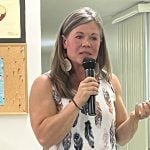When Shelley Moffat has a question about school work, she doesn’t raise her hand.
Instead, the 14-year-old from Wembley, Alta., near Grande Prairie, double clicks her computer mouse on the quickmail icon to send messages instantly to her teachers and classmates many kilometres away.
Welcome to CyberHigh.
There are 99 students and five teachers involved in Alberta’s CyberHigh project. The students, from grades seven to nine, take eight classes each.
Most, like Moffat, chose to attend high school via computer link rather than attend their local schools simply because they like computers.
Read Also

Alberta may eliminate marked fuel
Alberta may soon stop selling dyed gasoline and diesel.
But as rural schools across the Prairies face shrinking student populations and government cutbacks, school in cyberspace may be one way rural students who lose their local schools can stay at home and still get an education.
Garth Norris from the Alberta Education communications office said technology will play a major role in the future of education. The CyberHigh project “certainly holds a lot of potential” for rural education, he said.
Moffat and the other students paid to take part in the pilot project sponsored by the St. Albert Catholic School Division.
For $100, each received all the computer equipment and software required, as well as lessons on how to use the computers. When courses are completed, equipment and software are returned.
They follow courses the same way as conventional students, at specific times and according to a set schedule, but they do it in their living rooms instead of a classroom.
Of course, home study was not invented with the birth of the computer age and computer schooling isn’t the only choice for families that want their children to remain at home.
According to Alberta Education, there were 1,674 home education students in the province in 1990. Last year, there were 5,740 but the increase also reflects a new regulation that, as of last year, requires all home students to register.
In Saskatchewan, the number of home-schooled students has doubled from 730 in 1993 to an estimated 1,500 this year.
In Manitoba, Brian Henson of the Manitoba Teacher’s Society said the number of home-schooled students in that province has probably increased ten-fold over the past few years.
Alan Ramsay from the Saskatchewan Home-Based Educators said many families resist the idea of having their children on a school bus for hours every day and they are turning to home schooling.
“There’s definitely growth in the rural areas based on the inquiries we’ve had,” he said.
Mavis Cobb of Wroxton in east-central Saskatchewan is one of those parents. She has been home schooling her six children, from pre-schoolers to a 16 year-old, for four years.
When the school they attended in Dunleath closed, Cobb chose home schooling over having the children leave at 8 a.m. and return around 5 p.m. from school in Yorkton.
University of Saskatchewan education professor Michael Murphy thinks rural parents should take advantage of the opportunity to educate their children at home.
“Virtually every home-schooled child is highly socialized,” said Murphy. He said this runs counter to the belief that home-educated children are missing out on interaction with other kids.
On the other hand, he said, busing students to school takes time and “deprives the child of his childhood.”
Murphy, who home schooled his children, said studies show home-schooled children do well on exams, regardless of their parents’ level of education.
“You don’t need a PhD to be a home schooler,” said Murphy. But you do have to be a parent that stays at home.
“Of course somebody has to be there to teach the kids so it really wouldn’t work in a situation where both (parents) are working,” said Gene Hodgson from Saskatchewan Home Schooling. He said it is more likely that rural mothers will be at home than urban mothers.
And for those parents who do not want the responsibility of teaching their children themselves, a new course offered by the Saskatchewan Communications Network may provide the solution.
Last year, the University of Saskatchewan and SCN started an at-home broadcast course.
Phone in question
Students enrolled in the class tune in to watch lectures broadcast on the SCN channel on cable television. They send in completed assignments and phone in to ask questions.
Although only one at-home history course is offered, high schools and colleges around the province supplement course offerings with SCN classes that students can watch at school.
Officials involved with at-home education also caution that home study is not for everyone.
The lack of classroom discipline and structure may work against some students with poor study habits or without self-discipline.
It puts more onus on parents to determine that before opting for home study, they are certain their children are properly motivated to apply themselves without the steady overseeing of the teacher.














